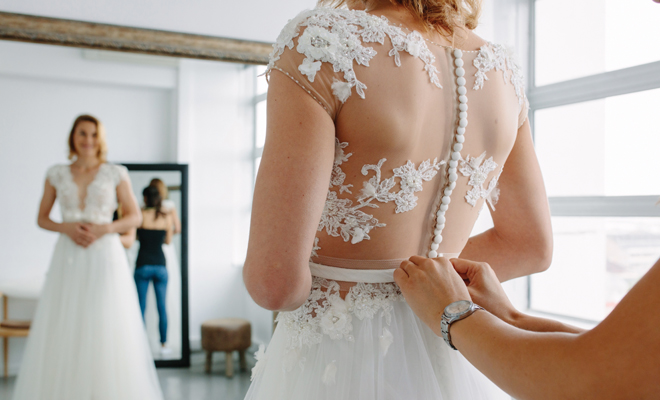
Needle Points: Tips from a Bridal Seamstress
Q: What should I keep in mind while shopping for my gown?
A: If at all possible, shop for your gown locally rather than ordering from a website. You never know how a gown will look on your body until you try it on in person, and many brides are surprised to find themselves choosing a different style than they initially anticipated after trying on a variety of gowns in a store.
In addition to helping you find your dream gown, the stylists at local bridal salons will help you choose the correct size; this is by far the most important factor when it comes to alterations. Most women’s bodies do not conform perfectly to a size chart, which is usually classified by your bust, waist and hip measurements. If you are between sizes, it is always best to choose the gown size that corresponds to the largest of the three measurements. It is much easier to alter the gown to fit your smaller measurements than to extensively change the design of the gown in order to make it larger; as the saying goes, buy up and size down!
Q: How much should I budget for gown alterations?
A: Typically, a bride can expect to spend between $300 to $600 for gown alterations. Of course, the more alterations you need for your gown, the higher the cost; other factors that contribute to cost are embellishments that require hand sewing such as a lace overlay, beading or appliqués. While shopping for your gown, it is always best to set aside more than you think is necessary for alterations to ensure you stay within your gown budget.
Q: How far before the wedding should I schedule my first fitting and what should I expect at each fitting?
A: Sooner is always better, but plan to schedule your initial fitting for about three months before the wedding. Most brides require three to five fittings to get the alterations perfect, usually with three weeks between each fitting. Many bridal seamstresses book up quickly during wedding season, April through September, so plan to call for an appointment as soon as you get your dress.
Generally, gown alterations are completed in several stages, working from the top down. At the first fitting, the seamstress will get an overview of what work needs to be done to your gown and will mark adjustments to be made to the bodice and straps. At the second fitting, the completed alterations to the bodice are checked and pinned again if further adjustments are needed. If the top now fits well, the seamstress will pin the hem to the correct length and perhaps begin work on the bustle. The third fitting may be your final fitting, or the process of measuring and adjusting is repeated until you look absolutely perfect in your gown!
Q: What should I do to prepare for my first fitting?
A: By far the most important task before you begin your fitting process is to decide on and purchase the suitable undergarments and shoes you will wear at your wedding. Not only are the exact undergarments required to begin the fitting process, the first fitting is also a great time to try everything on to ensure the gown and undergarments work well together.
One aspect of the gown most brides have never considered is what to do with the train after the ceremony. Most gowns require what is called a bustle to hook up the train during the reception, which consists of a series of hidden hooks or ribbons that, when fastened together, shorten the train to the length of the front of the gown. While not required, it helps to research the style of bustle you would like installed in your gown; American or French styles are the most common. At your fitting, the seamstress will advise you what style of bustle looks best, but a quick internet search will help you visualize how a bustle might look on your gown.
Q: What should I bring to my fittings?
A: It is crucial that you bring everything you will be wearing underneath your gown to all fittings. Shapewear, corsets, adhesive cups and all types of bras greatly change your body and thus the fit of the gown. Your seamstress will be unable to accurately fit your gown without the correct undergarments, so be prepared to reschedule your appointment if you do not have them.
In addition to undergarments, plan to bring the exact shoes you will be wearing with your gown to all fittings; heel height greatly affects the length of the gown as well as your posture. If you are changing into different shoes for the reception, bring those as well to check that they will also work with the length.
At the final fitting, it also helps to bring a member of the wedding party, usually a bridesmaid or maid of honor, so your seamstress can teach them how to bustle up the train after the ceremony–and so you can show off your finished gown! ■
Written by: Alyssa Diaz
Alyssa Diaz spent her childhood growing up in Connecticut and fell in love with Saratoga Springs, New York, when she moved to the area as a Skidmore College student. After graduating with a degree in business and studio art and then altering clothing for a few years for a local dry cleaner, Alyssa opened Altered State in Saratoga Springs in 2009. As owner and seamstress, she has specialized in altering women’s formalwear, prom and wedding gowns for the past ten years. In her spare time, Alyssa is passionate about traveling and hiking, especially in the national parks. For more information go to alteredstatesaratoga.com.








